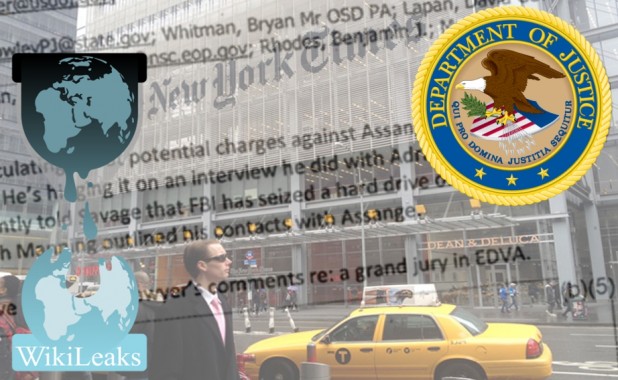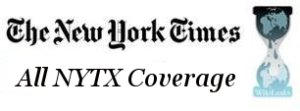WL FEATURED
C.I.A Release Emails on WikiLeaks Crisis Management
July 15, 2014 · 0 Comments

Above: Photo of NYT building and collage by NYT eXaminer.
By Preeti Kaur:
Recently released e-mails shine further light on the Central Intelligence Agency’s (C.I.A) late 2010 high-level meetings with New York Times and government officials centering on WikiLeaks and Chelsea (Bradley) Manning. The emails convey the difficulties that the C.I.A and numerous government agencies had in grappling with WikiLeaks’ seismic release of Collateral Murder, Afghan War Diary, Iraq War Logs, and Cablegate documents. The released C.I.A emails, published by NYT eXaminer, reveal the ways in which almost a dozen Obama administration functionaries colluded to disparage WikiLeaks and Julian Assange as engaging in conspiracy to commit espionage with Manning. A number of the officials involved in these meetings with the New York Times later went on to launch campaigns to discredit other whistleblowers.
The released emails come from the C.I.A in response to a NYT eXaminer Freedom of Information Act (FOIA) request. In April 2013, NYT eXaminer requested "copies of any [C.I.A] records for the three month period of November 1, 2010 through January 31, 2011 regarding communication the C.I.A had with New York Times' Bill Keller, the Times' Washington bureau chief Dean Baquet and their national security reporter Scott Shane - or any other representative of the Times - through in-person meetings, emails, and conference calls about Wikileaks' Cablegate and Bradley Manning."
NYT eXaminer founder Chris Spannos explained “Since January 2012 NYT eXaminer has made a number of FOIA requests in an attempt to understand why so-called ‘independent’ and leading media – in this case, the New York Times - sought meetings with representatives of the White House, U.S. State Department, Office of the Director of National Intelligence, C.I.A., Defense Intelligence Agency, F.B.I. and the Pentagon about WikiLeaks and Chelsea Manning. NYT eXaminer submitted FOIA’s to each of these entities. Understanding the relationship between this supposedly independent media outlet and U.S. agencies is crucially important to upholding the concept of a truly free and open press.”
Former Times Executive Editor, Bill Keller, has previously written emphatically and proudly about the relationship between the paper and government agencies. In January 2011 Bill Keller wrote “Dealing With Assange and the WikiLeaks Secrets,” which outlined how Dean Baquet (then Washington bureau chief – now successor to Bill Keller and Jill Abramson as the Times’ current Executive Editor) “gave the White House an early warning” on Nov. 19th 2010 that the paper had acquired WikiLeaks’ Cablegate data. The Times sought clearance from the Obama Administration on which cables to publish. Baquet is also known for blocking the publication of whistleblower revelations exposing NSA surveillance on U.S. citizens in 2006, when he worked at the LA Times.
Keller describes the way in which Baquet and others from the Times “were invited to a windowless room at the State Department” and met with representatives from the White House, the State Department, the Office of the Director of National Intelligence, the C.I.A., the Defense Intelligence Agency, the F.B.I. and the Pentagon.” Keller described others that “never identified themselves” but “lined the walls” in “off the record” meetings and that eventually gave way to daily conference calls.
Keller explained that “Before each discussion, our Washington bureau sent over a batch of specific cables that we intended to use in the coming days. They were circulated to regional specialists, who funneled their reactions to a small group at State, who came to our daily conversations with a list of priorities and arguments to back them up. We relayed the government’s concerns, and our own decisions regarding them, to the other news outlets.”
One recently released email thread from November 26, 2010 – sent just one week after Baquet “gave the White House an early warning” that they held WikiLeaks’ data – corroborates the conference calls that Keller described.
On December 15, 2010 Tracy Schmaler sent an email from the U.S. Department of Justice to eleven others providing advance warning of an article by Washington correspondent for the New York Times Charlie Savage about the U.S. strategy to ensnare Assange in conspiracy with Manning:
“All - Charlie Savage is working on a story speculating about potential charges against Assange revolving around conspiracy rather than espionage act. He's hinging it on an interview he did with Adrian Lamo, the hacker who turned Manning in. Lamo apparently told Savage that FBI has seized a hard drive of his showing conversations b/t Lamo and Manning in which Manning outlined his contacts with Assange.”
Savage’s article, “U.S. Tries to Build Case for Conspiracy by WikiLeaks,” previews themes that would later become central in films such as Alex Gibney’s “We Steal Secrets.” Schmaler’s Department of Justice email was sent to, among others, Assistant Secretary of Defense for Public Affairs Douglas Wilson. Incidentally, Wilson arranged for “Hurt-Locker” Director Kathryn Bigelow and screenwriter Mark Boal to gain access to high level C.I.A and Pentagon staff responsible for planning the extrajudicial killing of Osama bin Laden. Bigelow and Boal used the information obtained in their 2012 film “Zero Dark Thirty” which touched upon the U.S. use of torture and attempts at locating bin Laden.
Wilson was among others who sought to prioritize the film, “Boal has been working with us and with the C.I.A (via George Little) for initial context briefings – at DoD [Department of Justice] this has been provided by Mike Vickers, and at CIA by relevant officials with the full knowledge and full approval/support of [C.I.A] Director Panetta.” Jamie Smith, Director of Public Affairs at the Office of the Director of National Intelligence, involved in the discussions around the Times’ handling of WikiLeaks Cablegate data, was also point of contact [POC] for those who pushed for “Zero Dark Thirty”: “Would like to have whatever group is going around in here at the WH [White House] to get a sense of what they’re doing / what cooperation they’re seeking. Jamie will be POC.”
In the making of sympathetic films, various U.S. authorities show great capacity for cooperation and information sharing. Indeed, there is a long history of U.S., and other countries, supporting sympathetic cultural endeavors. Yet, in the disclosure of information in the public’s interest, such as the real numbers of known civilian deaths in Iraq, the U.S. State apparatus mobilizes to protect itself. Rather than acting independently, the New York Times seems ready to bend over backward to work with authorities and ensure that the "correct" information is made public.
Schmaler’s email warned that Savage’s NYT article referenced the Secret Grand Jury impaneled to try Assange for espionage. The C.I.A redacted information in the email they released to NYT eXaminer, but the newly unclassified emails show that it was also sent to many others, including Philip J. Crowley, who in March 2011 took a principled stance against the Pentagon for its mistreatment of military prisoner Chelsea Manning. Crowley, appalled by Manning’s treatment, resigned from his position as Assistant Secretary of State for Public Affairs later that March.
Also in receipt of Schmaler’s email was Bryan Whitman, Principal Deputy Assistant Secretary of Defense for Public Affairs. On November 28, 2010 Whitman informed his colleagues that in response to WikiLeaks’ publications, United States Central Command had, among other precautionary measures, established "Insider Threat Working Groups" to address “the Wikileaks incident and prevent reoccurrence,” and, “Informed all personnel of restrictions on downloading to government systems and cautioned regarding personal IT systems.” Such precautionary measures did not prevent further large-scale leaks from then NSA contractor, Edward Snowden, in 2013.
In March, last year, Tracy Schmaler, then Department of Justice Public Affairs Director and top-aid to Attorney General Eric Holder, resigned from the Department of Justice. They were suspected of leading a wide-spread attempt to discredit John Dodson. Dodson exposed the Bureau of Alcohol, Tobacco, Firearms and Explosives operation “Fast and Furious.” This operation was built to allow illegal gun trafficking to occur across the U.S.-Mexico border. The 2009 operation, an updated version of previous such operations, allowed guns to find their way into the hands of known drug cartels and criminals. Two of the operation’s guns were found at the scene of murdered customs and border agent Brian A. Terry in 2010. Reports indicate that Operation Fast and Furious sold up to 2,000 guns, with only 700 having been recovered.
Schmaler moved on to become a strategist in crisis communications for ASKG, a public relations firm, which aims to create “campaigns that shape public debate and influence policy." It is telling that she was responsible for relaying information about the New York Times article that would link Assange with espionage charges. Perhaps the beginning of an attempt to shape the public debate around WikiLeaks as an illegal organization rather than a legitimate publishing forum to arrange for the release of secret, sensitive and crucially important information.
By admin










Sorry, comments are closed on this post.